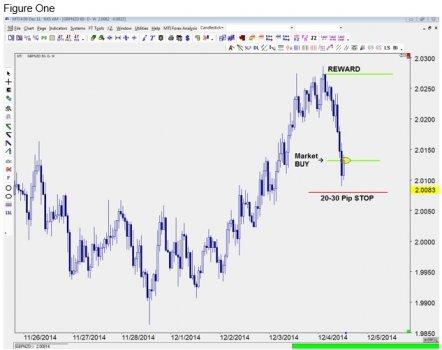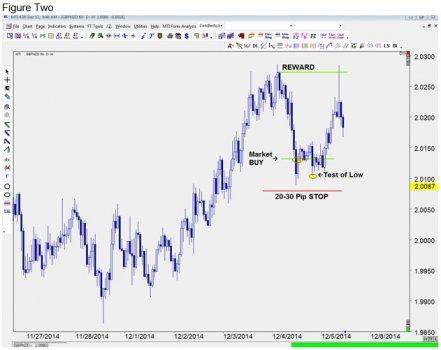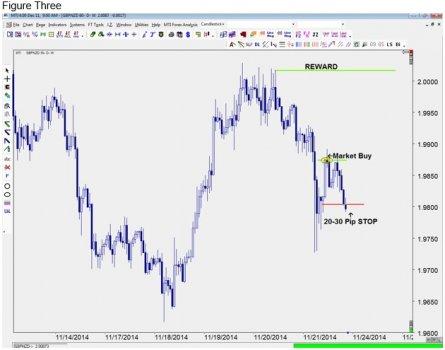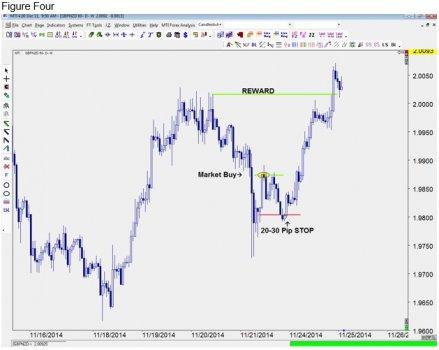Why does this phenomenon taunt traders? Because many traders abuse their stop-losses. Stop-losses are predetermined exits for losing trades. It in essence says that if the market were to not go their way in the trade, they would accept that much loss then call it a day. They know that the stop-loss is important, but when it comes to using it, they get it all wrong and no matter how on the money their technical analysis is, a poorly placed stop-loss will sabotage their trades every time. On top of this, an inappropriate stop-loss has caused many traders to cast aside perfectly profitable trading strategies and allowed costly emotional hijackings during game-changing trades.
Now, before we go any further, let me make this clear: stop-losses are very important. But, that doesn’t mean that they are not abused, misused and need to be improved in the way that we view them. Here’s the difference:
The great thing about the Forex market is that it historically does the same wave like patterns over and over again. Because the market repeats itself regularly in the same areas on the market chart pattern, a well-designed pattern-recognition strategy can be applied to take advantage of high percentage winning trades.
For example, inside of an uptrend, the market will make higher highs and higher lows. It’s our jobs as traders to buy the lows and sell the highs. Where the mistreatment of a stop-loss comes in is when a trader utilizes a strategy that allows them to buy low and then place that stop below the low. The goal is for the market to go their way. This sounds great right? This is the exact formula for consistent wins and a pretty little income, but there’s a catch; this only works in certain market conditions. The stop is meant to come in at a defined stop to say that if the market doesn’t go their way, they only lose so much of their trades. The difference: those particular market conditions determine the strategy, but many traders forget that those same market conditions also determine the stop-loss.
In this example, let’s say that the trader’s pre-determined stop is 30 to 50 pips away from their entry. An example of when this goes right can be seen through Figures 1 and 2. As the market fluctuates in volume throughout the months in the calendar year and as the distance between the high and the low of the day grows wider, conditions are ever-changing. With these changes in market condition, the required stop to their strategy may now need to be 80 to 100 pips from the entry. The problem is that the stop-loss often gets forgotten and left behind as the trader moves forward into the market and their trades with this strategy that once worked so well. The stop-loss becomes the black sheep in the scenario and it’s paid no mind.
The Fallout from a Forgotten Stop-Loss
Now, if the trader fails to place the larger stop to account for the larger differential between the high and low of the day, they start to lose because their 30 to 50 pip stop may not be below the low and is now in the way of the market’s test. Essentially, market conditions have changed and stop conditions have not. That’s when the trader says, “I’ve been stopped out right before the market goes my way, time after time, and it’s costing me money. I have to do something about this right now.” This is when a trader then says, “this strategy was very good, but now it’s terrible,” and they do away with a perfectly profitable strategy -- all because they have taken the stop-loss for granted. An example of this can be seen through Figures 3 and 4.There’s another main situation where the stop-loss is abused and the situation can turn very bad, very quickly. It typically happens when traders take initiative, are proactive and create their very own growth plan. How can this be bad? It’s what the growth plan is centered upon that does them in.
The Flaw of a Pip-Centered Growth Plan
Without even realizing what they are doing, many traders create a growth plan based upon how many pips they are going to risk per trade, rather than the percentage of their account that they’re going to risk. If a trader says that they are only going to risk 30 pips per trade based upon their growth plan if market conditions are right, they have a high winning percentage chance of making money. Then, their brain programs the welcome feeling that if they risk 30 pips, they’ll see returns, and then it happens. Market conditions change and now that winning trade requires a 60-pip risk to make money on any given position, which in turn raises the trader’s chance of incurring loss. Again, they re-evaluate their trades and blame the strategy, when indeed, the stop-loss is the one to blame or rather, their reluctance to alter their stop-loss to be in line with using that particular strategy on the new market conditions. In reality, the strategy is fine, but they should have cut their investment size in half and added pips, not risk to their stop.What does this look like in real life? Let’s say you were going to invest $1,000 per trade with a 30-pip stop-loss and are finding success. When the market conditions change and the fluctuations in the market grow larger in size, that 30-pip stop-loss is now too tight and those expected market testing candlesticks throw the trade out too early. Now, if the 60-pip stop-loss would allow for the trade to stay in the game so that the trade can weather the storm until the market moves in the trade’s direction, the initial investment per trade would need to decrease to accept this larger risk. So, instead of investing $1,000 per trade, the trader would see that the pips at risk doubled so the total investment must decrease by half, equaling around $500. This adjustment in the trade puts the risk and dollar amount for the strategy in line with one another.
Another example of market conditions changing like this happens monthly with the major fundamental announcements. When a big announcement is made, it’s not unusual for a trader to see the market’s candlesticks go from consisting of 12 pips to a now post-announcement 25 pips or more. Again, thinking of the stop-loss in relation to this, if the stop-loss is not increased during this period of time in preparation of the announcement’s release, the larger candles just throw the trader off. That stop-loss is too tight to handle the doubling in market volatility. Now when the market does its normal movements, the trade gets stopped out. And, from experience, I can say that when you’re getting stopped out over a handful of pips, it’s easy to see red and blame whatever you can find. Most people’s first reaction: blame the strategy.
Faulty Stop-Loss Blame
But, as with most things, there is another side of the coin where they go to the other extreme and instead of blaming the strategy, they blame the use of a stop-loss altogether. That situation looks like this: A trader is used to trading the same lot size for every trade when all of a sudden, they see a trade that they’re used to risking 40 pips now only requires a 12-pip risk. They click their heels. Could life get any better? So, then what? Do they just place the trade, business as usual? NO! The total pips at risk number is so small, they do away with equity management and they increase their lot size. Now when they lose, they lose much more and again, that stop-loss hasn’t been adjusted to the market conditions so they’re getting stopped out right before the market goes their way -- right before that massive win. They see this situation and how much profit could have been made in a trade and they say that the culprit is stop-losses in general. So, they take a vow to never use a stop-loss again. Now, surely I don’t have to finish how that stop-loss-less story ends, but if you must know, the typical result is a broken trader who blew up their account after experiencing one inevitable losing trade that should have been prepared for. As the saying goes, “there’s a million ways to make money in the Forex, but there’s only one way to lose it all, and that’s trading without a stop-loss.”The moral of the story: every strategy has a different stop-loss because that is a part of using that strategy successfully with the market’s expected tests. If any of the above situations sound like your trades lately, the fix is simple. Check your stop-loss. A couple pips-worth of tweaking could mean the difference between losing 70% of your trades and winning 70% of your trades.




Editors’ Picks
EUR/USD clings to daily gains above 1.0650

EUR/USD gained traction and turned positive on the day above 1.0650. The improvement seen in risk mood following the earlier flight to safety weighs on the US Dollar ahead of the weekend and helps the pair push higher.
GBP/USD recovers toward 1.2450 after UK Retail Sales data

GBP/USD reversed its direction and advanced to the 1.2450 area after touching a fresh multi-month low below 1.2400 in the Asian session. The positive shift seen in risk mood on easing fears over a deepening Iran-Israel conflict supports the pair.
Gold holds steady at around $2,380 following earlier spike

Gold stabilized near $2,380 after spiking above $2,400 with the immediate reaction to reports of Israel striking Iran. Meanwhile, the pullback seen in the US Treasury bond yields helps XAU/USD hold its ground.
Bitcoin Weekly Forecast: BTC post-halving rally could be partially priced in Premium

Bitcoin price shows no signs of directional bias while it holds above $60,000. The fourth BTC halving is partially priced in, according to Deutsche Bank’s research.
Week ahead – US GDP and BoJ decision on top of next week’s agenda

US GDP, core PCE and PMIs the next tests for the Dollar. Investors await BoJ for guidance about next rate hike. EU and UK PMIs, as well as Australian CPIs also on tap.
RECOMMENDED LESSONS
Making money in forex is easy if you know how the bankers trade!
Discover how to make money in forex is easy if you know how the bankers trade!
5 Forex News Events You Need To Know
In the fast moving world of currency markets, it is extremely important for new traders to know the list of important forex news...
Top 10 Chart Patterns Every Trader Should Know
Chart patterns are one of the most effective trading tools for a trader. They are pure price-action, and form on the basis of underlying buying and...
7 Ways to Avoid Forex Scams
The forex industry is recently seeing more and more scams. Here are 7 ways to avoid losing your money in such scams: Forex scams are becoming frequent. Michael Greenberg reports on luxurious expenses, including a submarine bought from the money taken from forex traders. Here’s another report of a forex fraud. So, how can we avoid falling in such forex scams?
What Are the 10 Fatal Mistakes Traders Make
Trading is exciting. Trading is hard. Trading is extremely hard. Some say that it takes more than 10,000 hours to master. Others believe that trading is the way to quick riches. They might be both wrong. What is important to know that no matter how experienced you are, mistakes will be part of the trading process.
